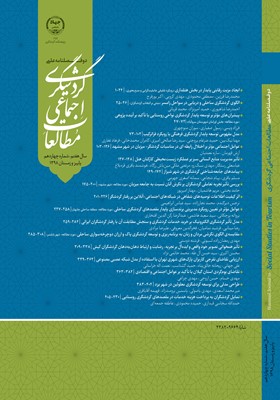ارزيابي تقاضاي تفرجي کاربران پارک هاي شهري تهران با استفاده از مدل شبکه عصبي مصنوعي
محورهای موضوعی :علی جهانی 1 , ریحانه خالق پناه 2 , حمید گشتاسب 3 , نعمت اله خراسانی 4
1 - محیط زیست کرج
2 - تهران
3 - تهران
4 - تهران
کلید واژه: تقاضاي تفرجي, پارک شهری, شبكه عصبي مصنوعي, کيفيت منظر, گردشگری شهری,
چکیده مقاله :
مزایای فضای سبز عمومی امروزه بخوبی روشن است؛ اما هنوز به سختی می توان گفت که کدام یک از پارک ها پتانسیل بالاتری جهت تأمین تقاضای تفرجی کاربران (گردشگران و شهروندان) دارند. هدف از اين مقاله مدل سازي ارزيابي تقاضاي تفرجي در پارک هاي شهري با استفاده از شبکه عصبي مصنوعي به منظور کشف روابط حاکم در رضايت مندي و تقاضاي تفرجي کاربران از پارک شهري است. 104 پارک شهري محلي، ناحيه اي و منطقه اي در مناطق 22گانه شهر تهران با تنوع بالا در کيفيت خدمات رفاهي و شيوه طراحي انتخاب گرديد. ارزيابي ميزان تقاضاي تفرجي در پارک هاي شهري با استفاده از ديدگاه درک کاربر محور صورت گرفته و نقش متغيرهاي منطقه اي و خدماتي در افزايش تقاضاي استفاده از پارک هاي شهري به روش اندازه گیری میدانی در سال 1395 تا 1396 بررسی شد. با توجه به نتايج شبكه هاي آموزش داده شده، مدل شبکه عصبی مصنوعی با توجه به بيشترين مقدار ضريب تبيين در سه دسته داده آموزش، اعتبارسنجی و آزمون، بهترين عملكرد بهينه سازي ساختار را نشان مي دهد. بر اساس نتايج آناليز حساسيت تعداد پارک هاي منطقه، مساحت امکانات ورزشي، مساحت امکانات فرهنگي و کيفيت منظر به ترتيب با ضريب اثرگذاري 5/183، 1/58، 7/52 و 4/30 بيشترين تاثير را در ميزان تقاضاي تفرجي کاربران در پارک هاي شهري از خود نشان دادند. مدل ارائه شده به عنوان يک سيستم پشتيبان تصميم گيري در طراحي مهندسي پارک هاي شهري شناخته مي شود. چنین رویکردی موجب توسعه شهرها بر اساس افزایش جاذبه های گردشگری و در نتیجه توسعه گردشگری شهری در سطح کلان می شود.
The advantages of public green spaces are clear. However, it is hard to estimate which parks provide higher standards for users’ (both tourists and citizens) recreational demands. This study provided a model to assess recreational demands in urban parks with the help of the artificial neural network. The aim was to clarify the rules of satisfaction among the users’ recreational demands in urban parks. In 22 districts of the city of Tehran, 104 local urban parks (with a high diversity of the quality of welfare services and design) were selected. Using the user-centered viewpoint, we assessed the recreational demand. A field study from 1395 to 1396 helped to investigate the role of the urban district and park service variables in increasing the demand for urban parks. Results of trained networks showed that the artificial neural network created the best function of topology optimization with a higher coefficient of determination in three categorists of training, validation, and test data. Sensitivity analysis showed that the number of urban district parks, sports areas, cultural areas, and the quality of landscape with a sensitivity coefficient of 183.5, 58.1, 52.7, and 30.4, respectively, had the highest effect on the users’ recreational demand in urban parks. The suggested model would be a decision support system in designing urban parks. Such an approach would help improve urban development based on tourism attractions and would develop urban tourism on a broader scale.
